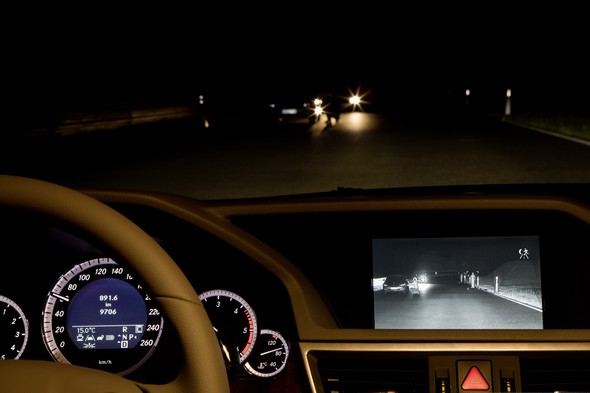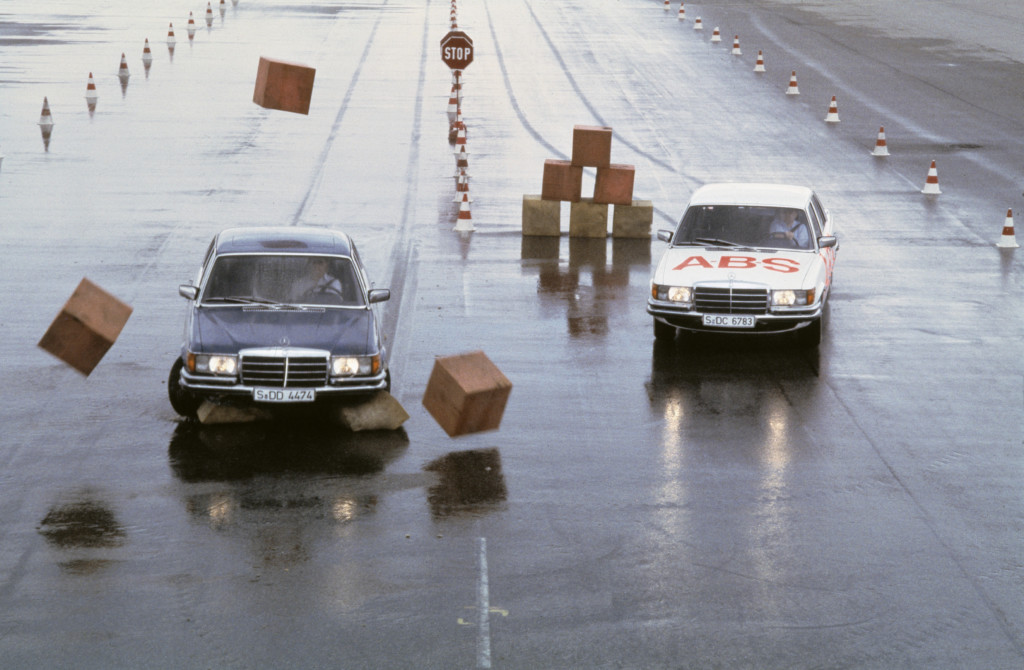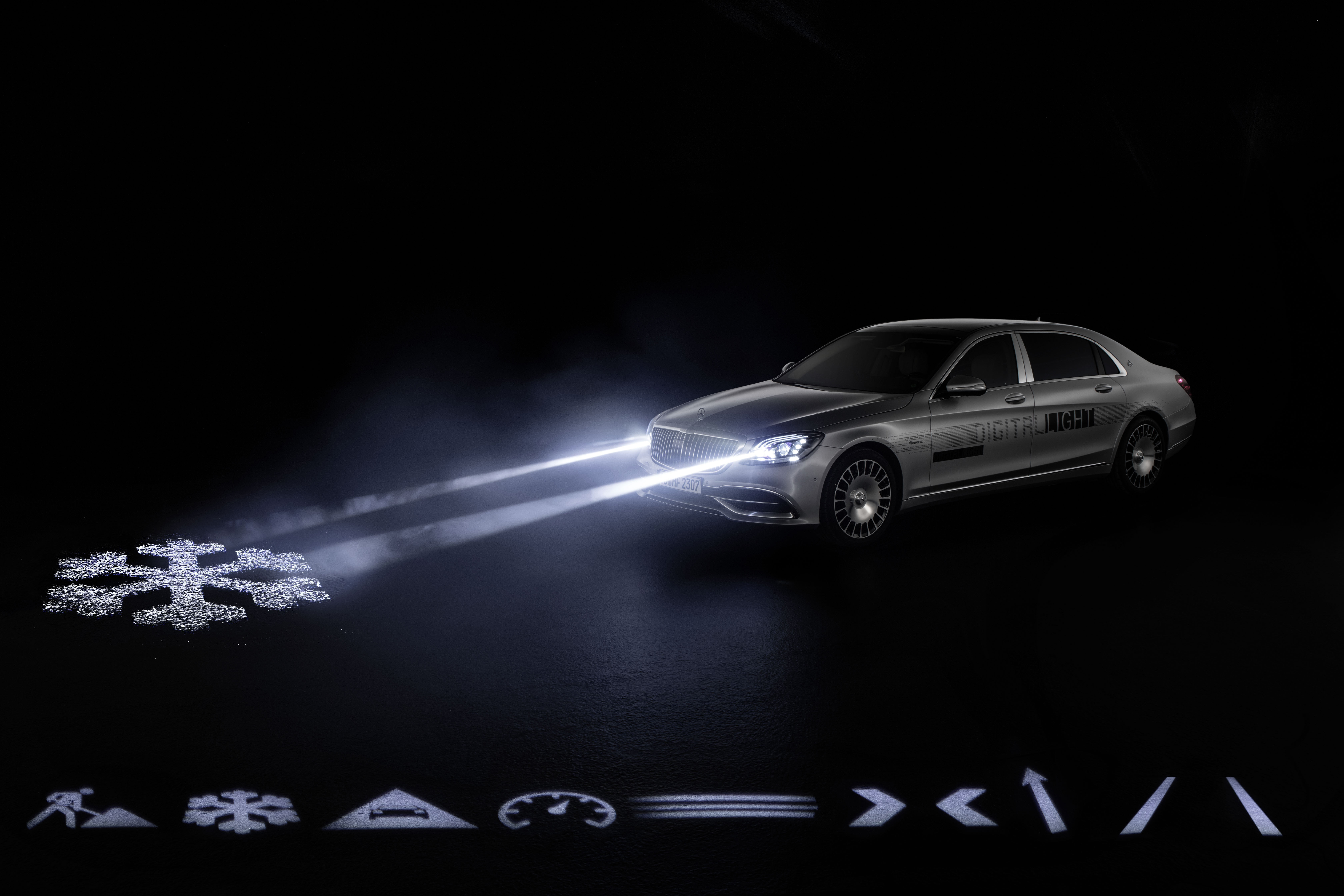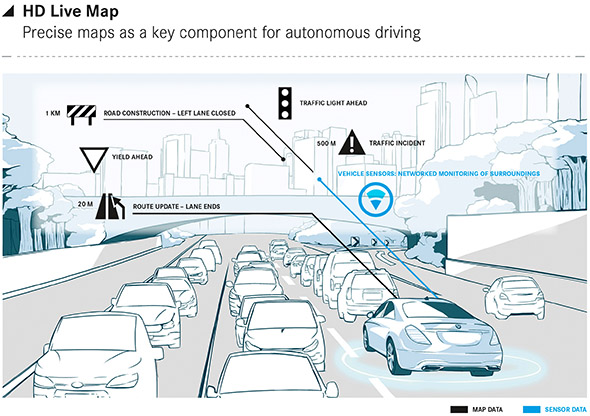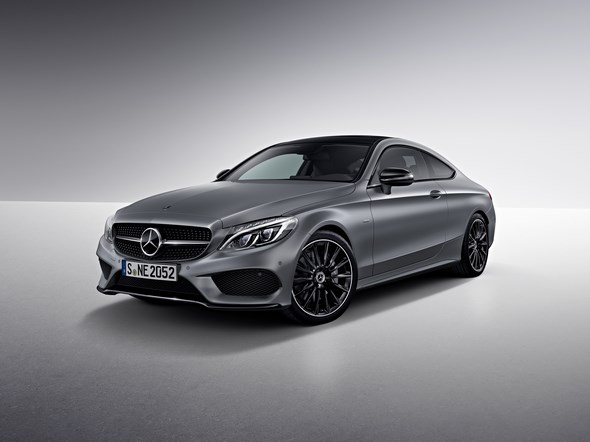Night View Assist

Infrared headlamps for improved long-range visibility

• New technology for the prevention of accidents at night
• Significantly better visibility than with conventional low-beam headlamps
• No dazzling of oncoming traffic
• Great safety potential confirmed in practical trials
The risk of serious injury in road traffic is much greater in twilight and in the dark than during daylight hours.
Although average traffic density is reduced to only around 15 percent at night, more than one in three fatal traffic accidents occur at this time.
Accordingly Mercedes-Benz has for many years been devoting great research efforts to making driving safer at night.
New developments such as xenon lowbeam headlamps (1995), bi-xenon headlamps (1999), the Active Light System (2003) and the cornering light function (2004) have made important contributions.
[adsense]Night view assist, which is celebrating its European premiere in the new S-Class, is a further milestone in this area of passenger car technology.
It is optionally available in conjunction with bi-xenon headlamps and the Active Light System.
This means that the new Mercedes flagship model has a unique package consisting of the best and most effective lighting technology currently available.
In the dark, the newly developed night view assist system provides the driver with a much greater range of vision than conventional low-beam headlamps, enabling the course of the road, pedestrians, cyclists and obstacles to be recognised much sooner.
At the same time the system relieves driver stress during tiring journeys at night, keeping the driver fit enough to respond rapidly and appropriately in critical situations.
Accident statistics: high risk for car drivers and pedestrians at night
This innovative system was developed on the basis of accident research:
- In 2003 there were 2630 fatalities in road accidents in twilight and darkness in Germany – this corresponds to almost 40 percent of all road traffic deaths in that year.
- In the USA there were 18,731 fatalities in twilight and darkness, almost 50 percent of all fatal accidents in the year 2003.
Accident researchers have concluded that problems of visual perception play a part in every second accident at night.
This is why they consider visibility from the vehicle and the early detection of other road users to have further potential for improving road safety in the hours of darkness.
The night view assist system in the new S-Class is able to make a major contribution to this, as accident analyses by Mercedes-Benz have confirmed: on the basis of data obtained from a joint accident research project conducted by German automobile manufacturers and the German road transport authority, Mercedes-Benz specialists have analysed the accident pattern at night and identified a high safety potential for night view assist.
During collisions at night there is a preponderance of cases where drivers lose control of their vehicle – often because they are unable to recognise the course of the road in time and do not adjust their speed.
Around 54 percent of these vehicles leave the road, and more than one quarter of these (26 percent) collide with oncoming traffic.
The new night view assist system can also help to improve the safety of pedestrians, as German accident statistics indicate that more than 55 percent of fatal accidents involving pedestrians occur in twilight or darkness.

Technology: infrared beams in the headlamps, camera on the windscreen
The night view assist system for the new Mercedes-Benz S-Class mainly consists of six components:
- The driver activates the system by means of a switch to the left of the rotary light switch. It must be dark outside and the low-beam beam headlamps must be switched on
- Two special searchlights in the headlamp housings illuminate the road ahead with invisible infrared light. When night view assist is active, these are automatically switched on when a speed of 15 km/h is reached, and remain on when braking down to about 10 km/h. Night view assist is not operational when reversing
- An infrared-sensitive camera on the inside of the windscreen records the scene ahead of the vehicle. A diffused-light panel protects the camera against extraneous light reflections
- An electronic control unit processes the image from the infrared camera and transfers it to the display in the instrument cluster as a clear greyscale image
As soon as night view assist is activated, the display in the centre of the instrument cluster is switched over to show the camera image.
The large eightinch display is directly in the driver’s field of vision, and he can use it like thespeedometer and cockpit instruments to glance down regularly, monitor the situation ahead of the S-Class as shown by the infrared image and adjust his driving accordingly.
When the system is switched on, the speed indication changes from a dial instrument to a horizontal, bar-type display at the lower edge of the camera image.
Practical trials: significantly more safety in critical situations Night view assist has the same range as main-beam headlamps, but without dazzling oncoming drivers.
Mercedes engineers examined the capabilities of this technology in a series of trials.
During comparative test drives with low-beam bi-xenon headlamps and the new night view assist system, the male and female test drivers recognised obstacles in the road much sooner when assisted by the infrared light system.
During tests, drivers were already able to discern test dummies at the roadside dressed in light-coloured clothing at a range of around 210 metres, which is about 41 metres sooner than with low-beam bi-xenon headlamps.
The system proves even more effective in the case of pedestrians in dark clothing. In these situations the night view assist system already enabled the drivers to identify the test dummies at a range of around 164 metres, but only at about 72 metres when driving with low-beam bi-xenon headlamps alone. This represents a safety improvement of no less than 125 percent.
Even when the headlamps of oncoming vehicles dazzle the driver and heavily obscure the view, visibility is much better with this support system: a test dummy in light-coloured clothing standing at the road edge 50 metres behind anoncoming vehicle was detected from an average distance of 140 metres with the help of night view assist – around 53 metres sooner than with low-beam bi-xenon headlamps.
Night View Assist PLUS with new function for highlighting pedestrians on the display
Mercedes-Benz will be offering Night View Assist – available for the S-Class since 2005 – for the new E-Class.
The system uses infrared technology to enhance the driver’s range of vision in the dark: two separate headlamps illuminate the road with invisible, non-reflective infrared light.
A windscreen-mounted cameradesigned to pick up precisely this type of light records what happens in front of the car and sends the image to a display on the dashboard.
The clear, needle-sharp greyscale image that appears here shows the scene in front of the car, allowing the driver to see pedestrians, cyclists or obstacles on the road at an early stage.
The Sindelfingen-based engineers have further developed Night View Assist and, in future, will be equipping it with a special pedestrian-detection function: as soon as the system detects pedestrians ahead of the car, they are highlighted on the display to make it easier for the driver to see them.
2011 Read more on the SPOTLIGHT function






